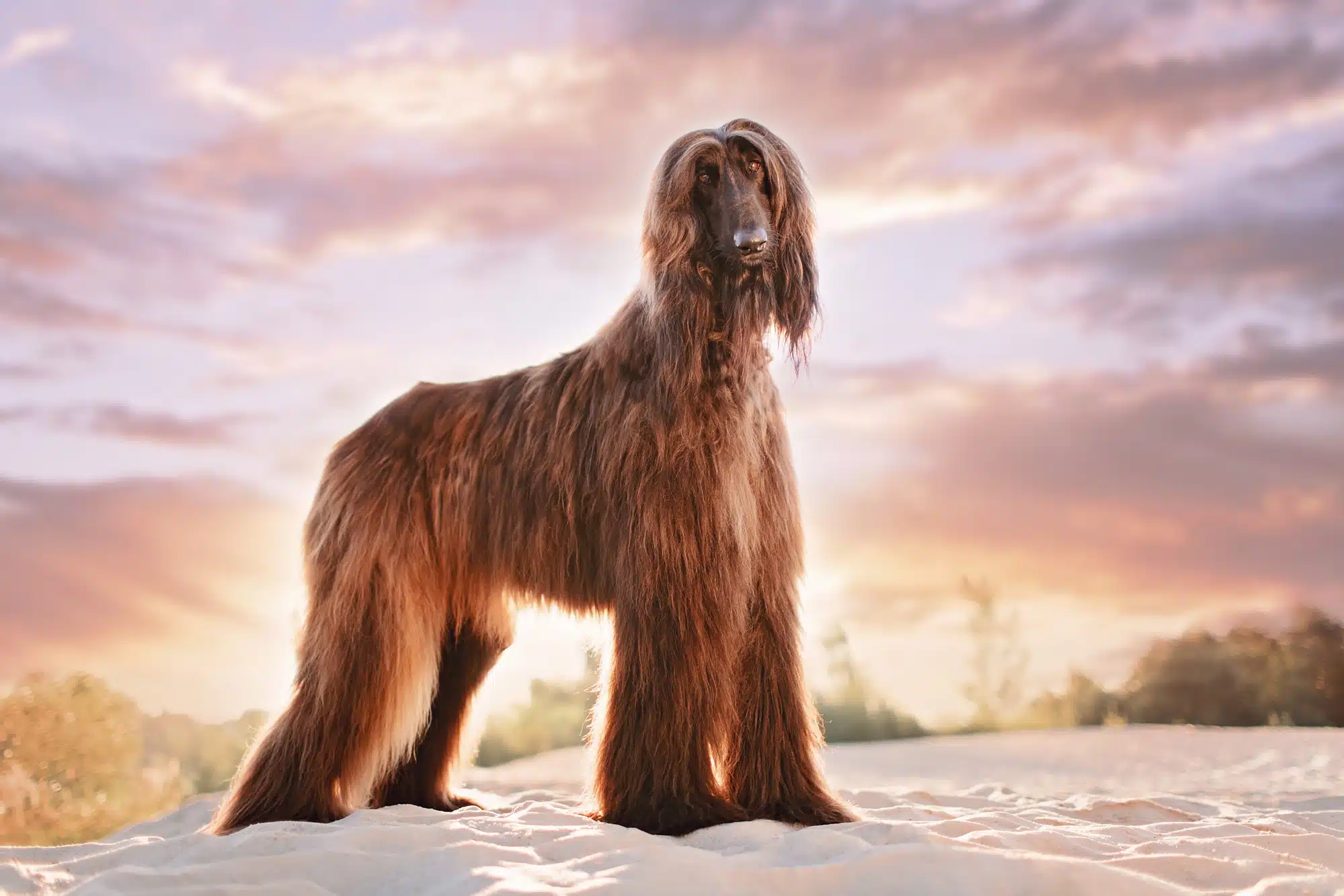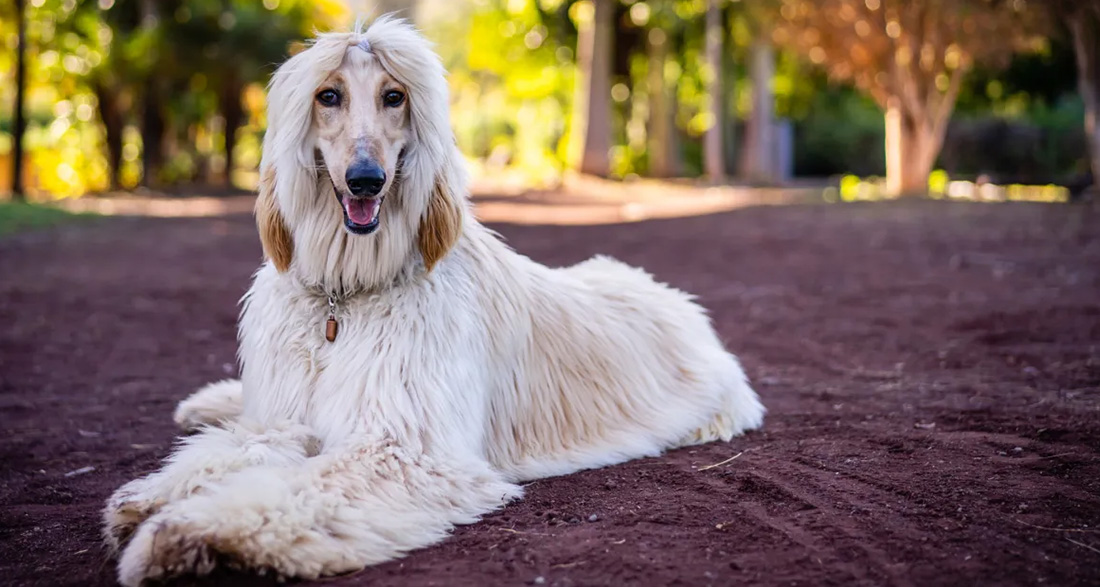An Afghan Hound, commonly referred to as Afghan, is one of the oldest sighthound breeds in the world. Thanks to its graceful appearance and long, silky coat, it enjoys immense popularity. Here in the profile, you’ll learn all about the history, temperament, and care of these original dogs.
History of the Afghan Hound
As early as 4000 BC, Afghan nomads in the Hindu Kush region bred the ancestors of the Afghan Hound. These agile hunting dogs were highly esteemed and considered precious. With their excellent hunting skills, the hounds ensured the survival of the nomads in the mountains. Additionally, they served as guard dogs for camps and villages. Three variants are known: the mountain, lowland, and short-haired Afghan. It wasn’t until the early 20th century that the first representatives of the breed made their way to America and Europe despite export bans.
Captain John Barff brought the male Zardin to England, who served as a model for the breed standard in the 1920s. The British Kennel Club recognized the “mountain Afghan” as an official breed. At this time, a division between show Afghans and racing Afghans was already emerging. The heavily overbred show animals often have coats that reach the ground, making normal movement impossible. In 1961, the FCI officially recognized the Afghan Hound. It belongs to FCI Group 10 “Sighthounds” in Section 1 “Long-haired or feathered sighthounds.” And in 1927, the breed was registered by the American Kennel Club (AKC).
Breed Overview
GROUP: Hound
HEIGHT: 25 to 27 inches at the shoulder
WEIGHT: About 50 to 60 pounds
TEMPERAMENT: Dignified, silly, aloof, happy, independent, quiet
COAT: Long, thick, and fine
COAT COLOR: Any color or combination of colors, including brindle and domino
HYPOALLERGENIC: Yes
LIFE SPAN: 12 to 14 years
ORIGIN: Afghanistan
Temperament and Character
The Afghan Hound is an independent yet affectionate dog. It is extremely people-oriented and sensitive but maintains its own mind. Submissiveness is foreign to these proud dogs, yet they are not aggressive either. A well-exercised Afghan Hound is an excellent family dog that interacts carefully with children. It possesses a strong hunting instinct that even professionals find challenging to manage.
However, within its four walls, it appears affectionate, gentle, and unobtrusive. It barks rarely and lacks guarding or herding instincts. The social hound also greets strangers and other dogs in a friendly manner.
| Affection Level | Medium |
| Friendliness | Medium |
| Kid-Friendly | Medium |
| Pet-Friendly | Medium |
| Exercise Needs | High |
| Playfulness | Medium |
| Energy Level | Medium |
| Trainability | Low |
| Intelligence | Medium |
| Tendency to Bark | Low |
| Amount of Shedding | Medium |
Appearance of the Afghan Hound
With a shoulder height of up to 74 centimeters, the Afghan Hound is one of the large dog breeds. Despite its size, it is not cumbersome but moves elegantly and gracefully. Its entire appearance exudes strength and dignity. The back is straight, gently sloping down towards the base of the single-curl tail. According to the AKC standard, the hip bones should be clearly visible, but the dog should not be too thin.
The muscular front legs end in large feet covered with long hair. The most distinctive feature of Afghan Hounds is their conspicuously long and silky coat. At the head, the hair forms a distinct topknot reminiscent of a lady’s hairstyle. In the saddle area, however, the coat is short and dense. While no specific color is prescribed, cream, silver, and black-brown colors are predominant.

Puppy Training
Due to its original use as an independent hunting dog, the Afghan Hound is not easy to train. It does not behave submissively but always maintains its pride and independence. With a lot of patience and consistency, you can teach the Afghan to obey. However, generally, it tries to do what it wants. It is particularly challenging to control the dog’s hunting instinct since it was originally a sight hound. As soon as it spots potential prey, it doesn’t hesitate and takes off.
Therefore, it’s important for these large dogs to learn basic commands at a young age. Afghan Hound enthusiasts will surely confirm that an Afghan Hound is capable of training its owner rather than the other way around.
Activities with the Afghan Hound
As the Afghan Hound is naturally a talented and fast runner, it requires adequate physical exercise. Unfortunately, in densely populated countries, satisfying the dog’s needs can be challenging. This is further complicated by the strong hunting instinct and the poor recall of the dogs. However, many Afghan Hound clubs offer the opportunity to participate in coursing or racing events. Here, the athletic dogs can run and race off-leash. For everyday activities, these dogs are also great companions for cycling or jogging.
Health and Grooming
Due to their long coat, especially Afghans from show lines require intensive grooming. You should ideally have experience for the professional care of the breed. Therefore, it’s advisable to get a grooming table and a selection of different combs and brushes. Even representatives of the breed with shorter coats should be combed intensively at least twice a week. Additionally, you must carefully remove dirt and knots from the coat after each walk. Generally, Afghan Hounds are very clean, shed little, and have little odor. When feeding, make sure that the long hair around the ears does not hang in the bowl.

Is an Afghan Hound Right for Me?
As future owners of an Afghan Hound, you should have experience with dogs or at least an understanding of the breed’s characteristics. The most important aspect of keeping a sighthound is to let it run freely regularly. So, you should have access to a fenced area that is large enough regularly. Ideally, you should have enthusiasm for dog racing.
If all the basic requirements are met, you should visit a breeder who belongs to a registered club. In the United States, these include the U.S. Sighthound Breeding and Racing Association or the American Afghan Breed Club. The cost for a purebred puppy with papers is approximately $1200. Before purchasing, also inspect the parents of the puppies and ensure that the breeder does not breed show dogs.
Interesting and Fun Facts
Artist Pablo Picasso owned an Afghan named “Kabul,” to whom he dedicated a huge statue in Daley Plaza, Chicago. His beloved four-legged friend is also seen in his painting “Femme au chien.”
In 1979, the famous Barbie doll got a four-legged companion: the Afghan Beauty. The toy duo found its way into numerous children’s rooms, further increasing the breed’s popularity.
The first successfully cloned dog was an Afghan Hound named “Snuppy.” In 2005, scientist Hwang Woo-Suk initiated the project. The dog developed healthily and even fathered ten healthy puppies. He lived to be ten years old and passed away in May 2015.
Oriental dogs also play a role in some movies. In the animated film “Balto,” alongside several Siberian Huskies, the Afghan lady Sylvie is featured. Additionally, Cruella de Vil from 101 Dalmatians owns some representatives of the breed.
Afghan Hound Overview
Pros
- Quiet breed, not a big barker
- Sweet and gentle nature
- Great chaser
Cons
- Requires fair amount of grooming
- Can be stubborn and has a tendency to be more self-directed
- Long hair makes it prone to ear infections
Do you have an Afghan Hound or are you planning to get one? Share with us in the comments what makes it so special in your opinion!


